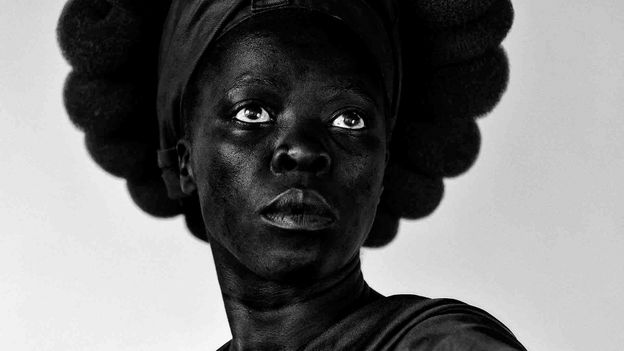
For many people in Europe, South Africa is still understood in the context of apartheid. However, this understanding often does not expand into how the system still affects black people in the country today, especially those in queer communities, who are still targets of violence. “People have a residual sense of what apartheid means, but in terms of what those experiences actually are, and the way they’re still playing out, that’s something that people are maybe not so aware of,” says Baker. The first series Muholi produced, titled Only Half the Picture (2003-2006), features photographs that simultaneously document intimate moments of people in the queer community, while also addressing past physical trauma. Aftermath (2004), for example, depicts the lower torso and legs of a person wearing briefs, a large scar visible on their right thigh.
But, for Muholi, their work also provides a space for the queer community to tell their own story, especially in South Africa. “You have museums in almost every European country, but you barely find properly allocated space for black LGBTQIA+ persons,” the photographer and activist says. London’s Tate Modern held a retrospective of Muholi’s work in 2020-21, co-curated by Sarah Allen and Yasufumi Nakamori, and among the essays in the exhibition catalogue is a testimony titled I am not a Victim but a Victor, written by Lungile Dladla, a South African lesbian. Dladla recounts an evening in 2010 when a man sexually assaulted her and her friend at gunpoint on their way home from her aunt’s funeral, calling it “corrective rape”: “He said, ‘Today ngizoni khipha ubutabane.’ (‘Today I will rid you of this gayness.’),” Dladla wrote. One of the series Muholi has become known for, titled Faces and Phases, includes a photograph of Dladla from 2006, dressed in a sweatshirt and bowtie.
Brave beauties
Faces and Phases is an ongoing collection of more than 500 black-and-white portraits of black lesbians and transgender people, depicted by Muholi in the ways the individuals themselves wish to be seen. In each image, the person looks straight at the camera, seemingly demanding the viewer to look at them properly. “Muholi is invested in making sure that the person being photographed feels and is genuinely in control of the way they’re being shown,” says Baker, noting that some of the people pictured also have recorded testimonials in the exhibition. “It’s always a process of discussion, an understanding between Muholi and the person they’re photographing.”